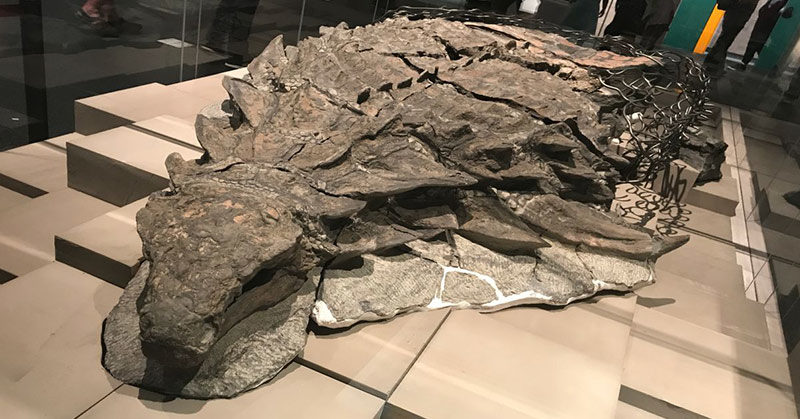Minors in Alberta, Canada, accidentally uncovered a fossilized dinosaur that was 110 million years old. This dinosaur was so well-preserved that instead of calling it a fossil, paleontologists are referring to it as a “dinosaur mummy”.
Researchers spent over seven thousand hours of painstaking work to uncover the remarkable find. Finally, the public got to meet the creature in 2017 at the Royal Tyrrell Museum.
A Dinosaur Mummy
Researchers are calling this find the most well-preserved dinosaur specimen anyone has ever found. 110 million years after the creature died, its skin, armor, and even some of its guts still remain intact.
“We don’t just have a skeleton,” said Caleb Brown, a researcher at the Royal Tyrrell Museum. “We have a dinosaur as it would have been.” [1]
The dinosaur is a member of the newly-discovered species, the nodosaur. It was an herbivore with four legs, that had spiky, plated armor. In total, it weighed approximately three thousand pounds. This dinosaur mummy is so intact that it still weighs 2500 pounds.
Visiting the nodosaur at the Royal Tyrrell Museum of Paleontology in Alberta, Canada, is unlike any other dinosaur experience. Instead of seeing bones, you will be looking at fossilized skin. The museum describes the animal as being “encased in intact body armour” [2].
A Dinosaur Mummy Named Mitch
The historic discovery happened in 2011. An excavator operator found the dinosaur mummy while digging in an oil sands mine in Alberta, Canada. Royal Tyrrell Museum technician Mark Mitchell then spent over seven thousand hours carefully excavating the creature from the ground.
For this reason, the researchers named the eighteen-foot-long dinosaur mummy Borealopelta markmitchelli, to honor the dedicated researcher [3].
Read: One Of The Few Known Intact Pyramid Capstones In Existence
How was the Nodosaur so Well-Preserved?
Scientists believe that a flooded river may have swept this nodosaur away. It likely carried it out to sea, where it eventually sank. As the animal sat at the bottom of the ocean for millions of years, minerals replaced the dinosaur’s armor and skin. This preserved the animal, allowing it to retain its original shape and size [2].
“This nodosaur is truly remarkable in that it is completely covered in preserved scaly skin, yet is also preserved in three dimensions, retaining the original shape of the animal,” said Brown. “The result is that the animal looks almost the same today as it did back in the Early Cretaceous.” [4]
The dinosaur mummy can also give us information about what life was like during that time in the earth’s history. Specifically, it gives us an idea of the types of threats the nodosaur was up against.
“Strong predation on a massive, heavily-armored dinosaur illustrates just how dangerous the dinosaur predators of the Cretaceous must have been,” explained Brown [4].
Just How Life-Like is this Dinosaur Mummy?
Scientists are incredibly impressed withhow intact this nodosaur is. So much so, that they are calling it “the Mona Lisa of dinosaurs”.
In fact, the dinosaur was so intact that scientists were able to determine the coloring of the animal. The researchers found pigments in the dinosaur’s scales using mass spectrometry techniques. Mass spectrometry is an analytical technique that measures the mass-to-charge ratio of ions [5]. They determined that the animal would have been a dark, reddish-brown on the top, but lighter on the underside of its body [3].
This is an example of countershading, which is yet another clue that this creature was under threat from predators. This type of coloration helps animals camouflage themselves. It is a common technique in animals today, like deer or penguins [6].
This dinosaur mummy is helping researchers to gain a better understanding of predator-prey relationships during the mesozoic era. For the rest of us, it’s offering a unique glimpse into the past with its stunningly life-like proportions.
“You don’t need to use much imagination to reconstruct it,” said Brown. “If you just squint your eyes a bit, you could almost believe it was sleeping.” [4]
Keep Reading: Boy Accidentally Finds 66-Million-Year-Old Dinosaur Eggs
Sources
- https://www.nationalgeographic.com/magazine/2017/06/dinosaur-nodosaur-fossil-discovery/
- https://edition.cnn.com/2017/05/14/americas/perfect-dinosaur-fossil-alberta-canada-museum-trnd/
- https://www.sciencealert.com/this-amazing-dinosaur-is-so-well-preserved-that-researchers-have-worked-out-its-weird-skin-colour
- https://www.scimex.org/newsfeed/the-mona-lisa-of-dinosaurs-discovered-in-canada
- https://www.broadinstitute.org/proteomics/what-mass-spectrometry
- https://www.cell.com/current-biology/fulltext/S0960-9822(17)30808-4

